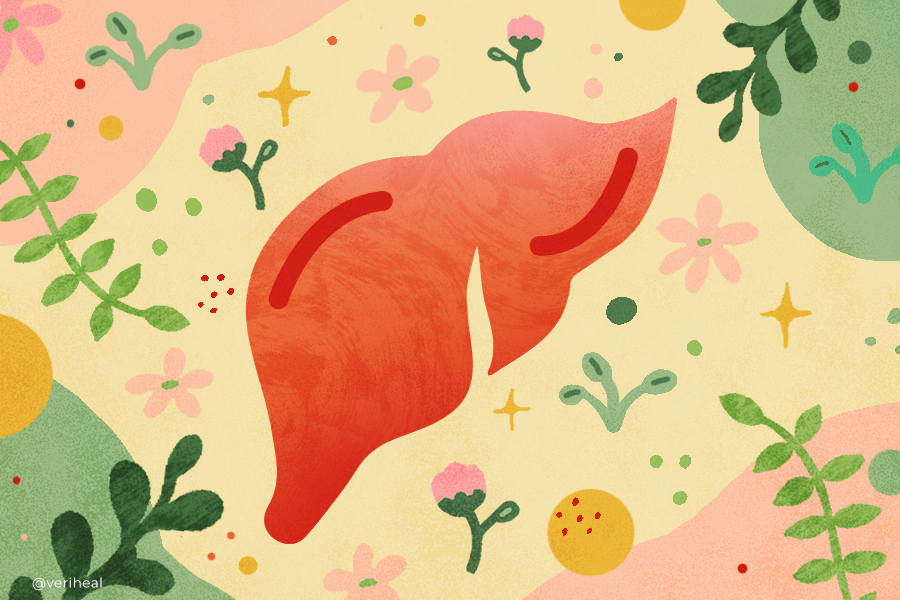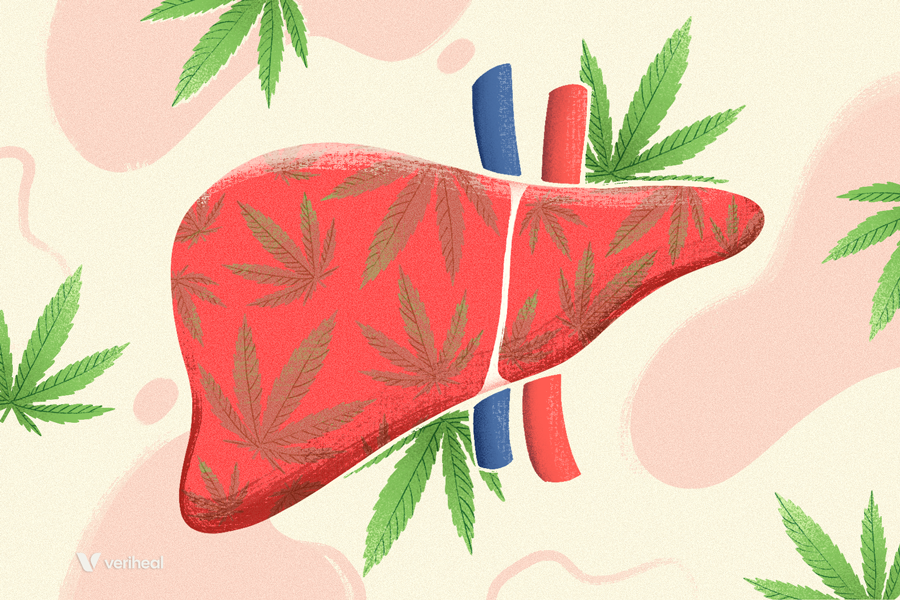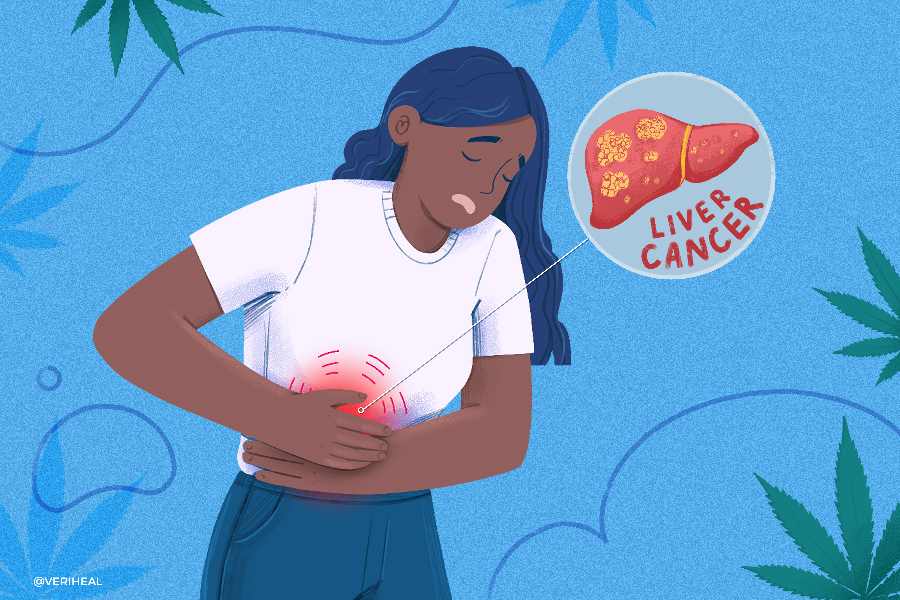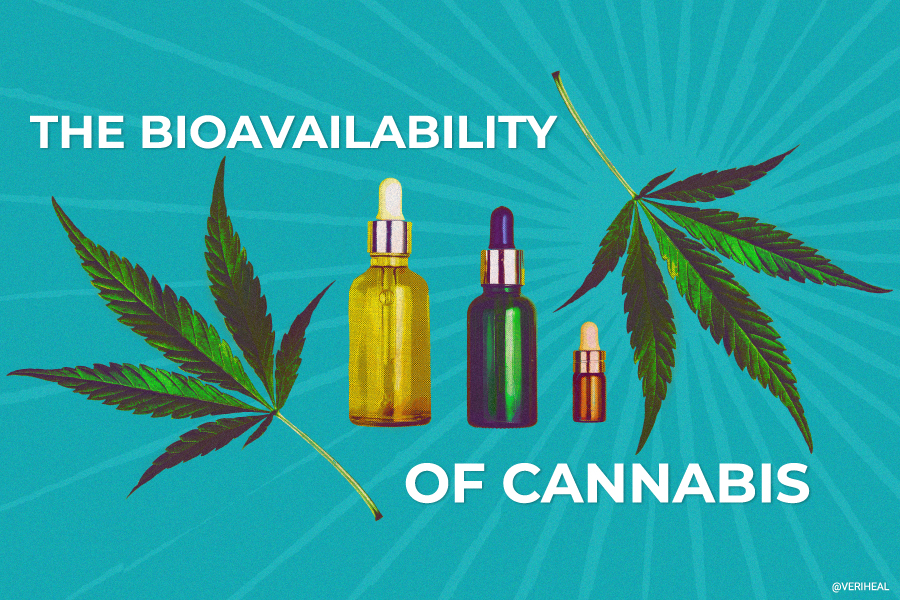Medical Cannabis for Liver Disease: What Are the Options?
While medical marijuana cannot be considered a cure for liver disease, it may relieve certain symptoms. Let’s find out what the science says and whether or not it’s worth trying this route for symptomatic relief and treatment.
The term liver disease refers to many diseases that target the liver, often resulting in serious damage and disease. According to the Liver Foundation, more than 100 million people in the U.S. have some type of liver disease (29). On top of this, approximately 5.5 million people in the U.S. have chronic liver disease or cirrhosis.
The liver is a vital organ that eliminates toxins from the body, cleans the blood, produces bile, and stores energy. So it’s important to keep it in good working shape. However, virus damage, toxin exposure, genetics, autoimmune factors, poor diet, and excessive alcohol intake may trigger the onset of liver disease, which may potentially be treated with medication and lifestyle changes.
How Does the Endocannabinoid System (ECS) Play a Role in Treating Liver Disease?
The endocannabinoid system (ECS) is an active and complex cell signaling network that begins with the ingestion of cannabinoids. There are over 120 cannabinoids found in medical cannabis, including Δ9-tetrahydrocannabinol (THC) and cannabidiol (CBD).
When cannabinoids are consumed, various cellular receptors are activated including cannabinoid receptors CB1 & CB2, peroxisome proliferator-activated receptors (PPARs), and transient receptor potential vanilloid (TRPVs). The receptors are able to regulate levels of endocannabinoids produced by the body.
Endocannabinoids are essentially fat-based neurotransmitters in the body. Anandamide (AEA) and 2-arachidonoylglycerol (2-AG) are the most studied endocannabinoids. Along with a few other endocannabinoids, AEA and 2-AG are responsible for regulating several different processes in the body including inflammation, pain perception, and appetite.
The ECS is a small portion of another system called the endocannabinoidome (eCBome). Researchers have found that the eCBome plays a vital role in the body, especially in the liver due to the presence of CB1 & CB2 receptors in healthy liver tissue (3).
Scientists believe that cannabinoid receptors are a potential therapeutic target for liver disease (14). AEA and 2-AG have been found in substantial levels within the liver. The liver also produces monoacylglycerol lipase (MAGL) and fatty acid amide hydrolase (FAAH), which are known to break down endocannabinoids in the body.
Researchers believe that an imbalance of the eCBome contributes to the development of liver disease. When the liver is damaged, the expression of CB1 & CB2 receptors of the liver is increased (14,3). This can lead to increased fat storage in fatty liver disease (hepatic steatosis) along with insulin resistance (27).
Additionally, non-alcoholic fatty liver disease (NAFLD) results from further imbalances relating to the activation of the endocannabinoid system. The ECS is responsible for appetite regulation and regulating the body’s efficiencies in using energy in a process called homeostasis (27).
In end-stage liver disease, the ECS has been shown to contribute to hepatic encephalopathy and vascular effects, including cirrhotic cardiomyopathy, portal hypertension, splanchnic vasodilatation, and relative peripheral hypotension (27).
Check out our page on clinical endocannabinoid deficiency for more information on how endocannabinoids may cause certain health conditions, including liver disease.
Are Cannabinoids a Good Treatment Option for Liver Disease?
There is a lot of research being conducted on both cannabinoids and endocannabinoids in relation to the liver, but more research is needed to determine if medical marijuana use is a safe option for patients with liver disease.
Depending on the symptoms a patient is experiencing from liver disease, medical cannabis may have the potential to make it worse by the overactivation of CB receptors and potentially increasing the levels of endocannabinoids in the already damaged liver tissues (27).
A 2023 study found in Cannabis and Cannabinoid Research observed the long-term use of CBD in patients who have had elevated alanine transaminase (ALT) blood levels. The study examined CBD use in 839 patients between the ages of 18 and 75 (8).
Participants did initial blood testing and then blood testing again after 30 days of self-selected CBD product use (8). Researchers concluded that the use of CBD was not associated with an increase in liver tests. There are no significant links between routine CBD dosing and liver enzyme levels in healthy adults.
There is also research into prescriptions that are able to slow down the expression of CB1 receptors. These medications work the opposite of medical cannabis as cannabis typically activates CB receptors and increases endocannabinoid levels.
One such study examined the use of CB1 antagonist rimonabant in mice with induced and obesity-related hepatic steatosis (fatty liver disease) and metabolic disease (5).
The mice were put under strict observation and temperature control during the 8 weeks of the study. Researchers found that rimonabant was able to heal and stop the progression of hepatic steatosis in the mice. This was found because of testing that showed decreased signs of liver damage including blood levels of alanine aminotransferase (ALT), gamma-glutamyltransferase (GGT), and alkaline phosphatase (ALP) (5). Rimonabant also reduces inflammatory markers and dyslipidemia (high cholesterol, triglycerides, and free fatty acids).
This is exciting research because it shows that we may potentially be able to use the eCBome as a potential target for slowing the progression and potentially reversing the damage caused by chronic or fatty liver disease and metabolic syndrome.
More research is needed to further investigate the role of endocannabinoids in liver disease and if marijuana is a safe treatment option.
What Cannabis Preparations Are Suitable for Liver Disease?
One of the main appeals associated with medical cannabis use to treat liver disease symptoms is the variety of cannabis preparations on offer. What works for one person might not work for another, so it’s best to experiment and start with a low dosage. Options include:
- Edibles
- Pills, capsules, and tablets
- Transdermal patches
- Vapes and inhalational routes
- Tinctures and edibles
- Suppositories
Thoughts to Consider
If you are considering using medical cannabis while you have liver disease or to treat liver disease, it is essential to let your healthcare provider know about it and any other medications you are taking. It is possible for certain medications and supplements to cause damage to the liver alone or in combination with CBD (e.g. antiepileptic drugs).
Why is The Liver Important?
After the skin, the liver is the second-largest organ in the human body. It is positioned just beneath the ribcage on the right side and is the size of a football. Its primary job is to separate nutrients and waste as they travel through the digestive system (9).
The liver is considered a vital organ for life. It is responsible for hundreds of functions in the body. It is also considered a gland because it makes proteins and hormones that are used by other parts of the body (12).
Some of the major jobs of the liver include (12):
- Cleaning and filtering toxins from blood
- Removes old red blood cells
- Makes bile for digesting food
- Metabolizes fats, proteins, and carbohydrates so the body can use them
- Produces clotting factors that help blood clot
- Regulates the amount of blood in the body
- Stores vitamins and glycogen (a form of glucose or sugar) for the body to use later
What is Liver Disease?
The broad medical term liver disease encompasses several medical conditions that can affect the liver. You may also see the term “hepatic” which can be used in place of the word liver to describe these conditions. Many medical professionals use the terms liver damage and hepatic damage interchangeably.
Some types of liver disease rarely cause physical symptoms but are still detectable by medical professionals (9). Other forms have noticeable symptoms that may include (9):
- Right-sided abdominal pain
- Jaundice is a condition that happens when the liver is unable to clear bilirubin
- Appears as yellow skin or the whites of the eyes are yellow
- Fatigue
- Nausea & vomiting
- Swelling of the arms or legs
- Bruising easily
- Appetite loss (11)
- Dark-colored urine (11)
- Pale or white stools (11)
- Itchy skin (11)
Liver Disease Causes
The liver can suffer from several different complications because the liver performs a variety of functions in the body. Some types of liver disease can be genetic, while others can be caused by (11):
- Viral infections:
- Hepatitis A virus
- Hepatitis B virus
- Hepatitis C virus
- Cancer (9):
- Liver cancer
- Bile duct cancer
- Liver adenoma
- Genetic diseases such as:
- Systemic autoimmune diseases include:
- Primary sclerosing cholangitis (PSC) (22)
- Primary biliary cirrhosis (PBC)
- Autoimmune hepatitis
- Systemic lupus erythematosus (SLE) (4)
- Primary antiphospholipid syndrome (4)
- Polymyositis (4)
- Sjögren’s syndrome (4)
- Systemic Sclerosis (4)
- Rheumatoid arthritis (4)
- Adult Still’s disease (4)
- Felty’s syndrome (4)
- Vascular diseases or complications such as:
- Alcohol use disorder (AUD)
- Taking certain medications such as amiodarone, isoniazid, methotrexate, phenytoin, and nitrofurantoin (22)
Types of Liver Disease
There are several different types of liver disease. Some patients develop liver lesions, cysts, or abnormalities with the blood supply of the liver, but these conditions are not always reasons to be concerned and may just need to be watched over time by a healthcare professional. Some of the common types of liver disease are discussed below.
Alcoholic Liver Disease
Patients who suffer from alcohol use disorder may damage their liver from drinking. This damage ranges from minor and reversible conditions such as fatty liver and alcoholic hepatitis (22). These conditions may be controlled by eliminating alcoholic beverages.
Patients who are unable to abstain from alcohol may progress into developing chronic liver disease (CLD) (22). The most severe form of alcoholic liver disease is cirrhosis. Cirrhosis occurs when the liver suffers from so much damage it is unable to heal itself and the liver begins to shut down. Without a transplant, cirrhosis patients have a life expectancy of up to two years after diagnosis. Unfortunately, liver transplants are often denied to patients who cannot completely abstain from alcohol drinking for a sustained period, making cessation imperative in treatment.
Non-alcoholic Fatty Liver Disease ( NAFLD/NASH)
NAFLD patients develop CLD without the involvement of alcohol. It is caused by metabolic diseases such as obesity, diabetes, and hyperlipidemia (22). This has become much more common in recent years as obesity rates have sharply increased.
Hepatitis
Inflammation of the liver, or hepatitis, is typically caused by specific viral infections that include hepatitis A, B, and C (22). Autoimmune hepatitis can also be caused by a weakened immune system in patients who have chronic health issues such as HIV or AIDs (22). It may also occur spontaneously, much like other autoimmune conditions.
Hepatitis can also be triggered by alcohol abuse and alcoholic liver disease.
Primary Sclerosing Cholangitis (PSC)
This type of liver disease is associated with ulcerative colitis (22). PSC is characterized by a decrease in the size of liver bile ducts caused by inflammation and fibrosis.
Primary Biliary Cirrhosis (PBC)
PBC is considered a type of autoimmune and progressive liver disease (22). It leads to the destruction of intrahepatic biliary channels in the liver as well as portal vein inflammation and scarring.
Hemochromatosis
A genetic cause of liver disease, hemochromatosis is a disorder that causes the body to build up too much iron in the bloodstream, and subsequently soft tissues (6). It leads to damage to organs including the liver, heart, pancreas, endocrine glands, and joints.
Wilson’s Disease
Another genetic disorder, Wilson’s disease causes the body to build up too much copper (25). The copper build-up leads to damage to the liver, brain, and eyes.
Other Types of Liver Disease
A long list of rare liver diseases also exists. In the United States, the disease is deemed to be “rare” if it is diagnosed in less than 200,000 people at any given time. Examples of rare liver diseases include (20):
- Alagille Syndrome
- Acute Hepatic Porphyria
- Biliary Atresia
- Crigler-Najjar Syndrome
- Galactosemia
- Glycogen Storage Disease
- Lysosomal Acid Lipase Deficiency
Talking to Your Doctor About Liver Disease Treatments
A doctor visit is essential for diagnosing liver-related issues, such as liver disease. To diagnose liver issues, a doctor will start by taking your medical history and performing a physical examination.
*It is important to seek immediate medical help if you are experiencing severe abdominal pain as this could be an indication of a medical emergency.
The doctor may perform tests to determine what is causing your symptoms and to check the health of the liver. These tests may include (9):
- Biopsy – Tissue samples can be extracted from the liver to spot the signs of scar tissue. This sample (biopsy) is then sent to a laboratory, where scientists can pinpoint the cause of liver disease.
- Imaging tests – Getting a closer look at the liver is made easy with imaging technology in the form of an ultrasound, a CT scan, or an MRI.
- Blood liver function tests – Liver function tests are designed to check the specific levels of various enzymes and proteins in your blood. These enzymes and proteins are imperative for proper liver functioning and therefore if there are signs of a deficiency, disease may occur.
- Alternative blood tests – Genetic conditions and viral hepatitis, among many other liver damage-causing conditions, can be tested for with a complete blood count.
Complementary Treatments Worth Discussing with Your Doctor
There are a range of complementary treatment options out there that can be harnessed to potentially enhance liver health and speed up the healing process. In addition to using medication or undergoing surgery for liver disease, you may consider joining some kind of medical program that includes careful monitoring of liver functions (10).
If you consume alcohol, do so sparingly, or best, not at all. Processed carbohydrates, trans fats, red meat, and foods containing high-fructose corn syrup should be avoided. Should you be overweight when you’re diagnosed with liver disease, you should cut your caloric intake by 500-1,000 per day. Daily exercise for 30-60 minutes around 3-4 times weekly is also recommended.
Keep in mind that while medical marijuana and other complementary medicines can prove beneficial for you or a loved one with liver disease, you must continue using any medication or treatments that are prescribed by your doctor.
It is also extremely important to let your doctor know about any medications or supplements that you are taking, as they may cause drug interactions or further progress the damage to your liver.
Note: Veriheal does not intend to give this as professional medical advice. Do not attempt to self-diagnose or prescribe treatment based on the information provided on this page. Always consult a physician before making any decisions on the treatment of a medical condition.
1. Andrews, Christopher, Devlin, Shane. Le Foll, Bernard, Fischer, Benedikt, Tse, Frances, Storr, Martin, and Congly, Stephen.Canadian Association of Gastroenterology Position Statement: Use of Cannabis in Gastroenterological and Hepatic Disorders | Journal of the Canadian Association of Gastroenterology (April 2019). Retrieved August 19, 2023, from https://doi.org/10.1093/jcag/gwy064
2. Adjumo, Adeyinka, Ajayi, Tonkunbo, Adegbala, Kelechi, Alliu, Samson, Akinjero, Akintunde, Onyeakusi, Nnaemeka, Ojelabi, Ogooluwa, and Bukong, Terence. Cannabis use is associated with reduced prevalence of progressive stages of alcoholic liver disease. Liver International—Wiley Online Library. (January 2018). Retrieved August 19, 2023, from https://doi.org/10.1111/liv.13696
3. Bazwinsky-Wutschke, I., Zipprich, A., & Dehghani, F. (2019). Endocannabinoid System in Hepatic Glucose Metabolism, Fatty Liver Disease, and Cirrhosis. International journal of molecular sciences, 20(10), 2516. https://doi.org/10.3390/ijms20102516
4. COJOCARU, M., COJOCARU, I. M., SILOSI, I., & VRABIE, C. D. (2013). Liver Involvement in Patients with Systemic Autoimmune Diseases. Mædica, 8(4), 394–397. https://www.ncbi.nlm.nih.gov/pmc/articles/PMC3968480/
5. Gary-Bobo, M., Elachouri, G., Gallas, J. F., Janiak, P., Marini, P., Ravinet-Trillou, C., Chabbert, M., Cruccioli, N., Pfersdorff, C., Roque, C., Arnone, M., Croci, T., Soubrié, P., Oury-Donat, F., Maffrand, J. P., Scatton, B., Lacheretz, F., Le Fur, G., Herbert, J. M., & Bensaid, M. (2007). Rimonabant reduces obesity-associated hepatic steatosis and features of metabolic syndrome in obese Zucker fa/fa rats. Hepatology, 46(1), 122–129. https://doi.org/10.1002/hep.21641
6. Hemochromatosis—NIDDK. (n.d.). National Institute of Diabetes and Digestive and Kidney Diseases. Retrieved August 22, 2023, from https://www.niddk.nih.gov/health-information/liver-disease/hemochromatosis
7. How Many People Have Liver Disease? – American Liver Foundation. (2022, July 29). https://liverfoundation.org/about-your-liver/facts-about-liver-disease/how-many-people-have-liver-disease/
8. Kaufmann, R., Aqua, K., Lombardo, J., & Lee, M. (2023). Observed Impact of Long-Term Consumption of Oral Cannabidiol on Liver Function in Healthy Adults. Cannabis and Cannabinoid Research, 8(1), 148–154. https://doi.org/10.1089/can.2021.0114
9. Liver Disease: Types, Causes, Symptoms and Treatment. (n.d.). Cleveland Clinic. Retrieved August 19, 2023, from https://my.clevelandclinic.org/health/diseases/17179-liver-disease
10. Liver problems—Diagnosis and treatment—Mayo Clinic. (n.d.). Retrieved August 19, 2023, from https://www.mayoclinic.org/diseases-conditions/liver-problems/diagnosis-treatment/drc-20374507
11. Liver problems—Symptoms and causes—Mayo Clinic. (n.d.). Retrieved August 19, 2023, from https://www.mayoclinic.org/diseases-conditions/liver-problems/symptoms-causes/syc-20374502
12. Liver: What It Does, Disorders & Symptoms, Staying Healthy. (n.d.). Cleveland Clinic. Retrieved August 19, 2023, from https://my.clevelandclinic.org/health/articles/21481-liver
13. Mallat, A., & Lotersztajn, S. (2010). Endocannabinoids and their role in fatty liver disease. Digestive Diseases (Basel, Switzerland), 28(1), 261–266. https://doi.org/10.1159/000282100
14. Mallat, A., Teixeira-Clerc, F., Deveaux, V., Manin, S., & Lotersztajn, S. (2011). The endocannabinoid system as a key mediator during liver diseases: New insights and therapeutic openings. British Journal of Pharmacology, 163(7), 1432–1440. https://doi.org/10.1111/j.1476-5381.2011.01397.x
15. Mallet, Ariane, Teixeira-Clerc, Fatima, and Lotersztajn, Sophie.Cannabinoid signaling and liver therapeutics—ScienceDirect. (March 2013). Retrieved August 22, 2023, from https://doi.org/10.1016/j.jhep.2013.03.032
16. Mallat, A., Teixeira-Clerc, F., & Lotersztajn, S. (2013). Cannabinoid signaling and liver therapeutics. Journal of Hepatology, 59(4), 891–896. https://doi.org/10.1016/j.jhep.2013.03.032
17. Mboumba Bouassa, R.-S., Sebastiani, G., Di Marzo, V., Jenabian, M.-A., & Costiniuk, C. T. (2022). Cannabinoids and Chronic Liver Diseases. International Journal of Molecular Sciences, 23(16), 9423. https://doi.org/10.3390/ijms23169423
18. Pacher, P., & Gao, B. (2008). Endocannabinoids and Liver Disease. III. Endocannabinoid effects on immune cells: Implications for inflammatory liver diseases. American Journal of Physiology-Gastrointestinal and Liver Physiology, 294(4), G850–G854. https://doi.org/10.1152/ajpgi.00523.2007
19. Parfieniuk, A., & Flisiak, R. (2008). Role of cannabinoids in chronic liver diseases. World Journal of Gastroenterology : WJG, 14(40), 6109–6114. https://doi.org/10.3748/wjg.14.6109
20. Rare Liver Diseases. (n.d.). Community Liver Alliance. Retrieved August 22, 2023, from https://communityliveralliance.org/rare-liver-diseases/
21. Rare Liver Diseases—Community Liver Alliance. (n.d.). Retrieved August 22, 2023, from https://communityliveralliance.org/rare-liver-diseases/
22. Sharma, A., & Nagalli, S. (2023). Chronic Liver Disease. In StatPearls. StatPearls Publishing. http://www.ncbi.nlm.nih.gov/books/NBK554597/
23. Subbaraman, M. S., Metrik, J., Patterson, D., & Swift, R. (2017). Cannabis use during treatment for alcohol use disorders predicts alcohol treatment outcomes. Addiction (Abingdon, England), 112(4), 685–694. https://doi.org/10.1111/add.13693
24. Tam, J., Liu, J., Mukhopadhyay, B., Cinar, R., Godlewski, G., & Kunos, G. (2011). Endocannabinoids in liver disease. Hepatology, 53(1), 346–355. https://doi.org/10.1002/hep.24077
25. Wilson Disease—NIDDK. (n.d.). National Institute of Diabetes and Digestive and Kidney Diseases. Retrieved August 22, 2023, from https://www.niddk.nih.gov/health-information/liver-disease/wilson-disease
26. Xu, X., Liu, Y., Huang, S., Liu, G., Xie, C., Zhou, J., Fan, W., Li, Q., Wang, Q., Zhong, D., & Miao, X. (2006). Overexpression of cannabinoid receptors CB1 and CB2 correlates with improved prognosis of patients with hepatocellular carcinoma. Cancer Genetics and Cytogenetics, 171(1), 31–38. https://doi.org/10.1016/j.cancergencyto.2006.06.014
27. Zamora-Valdes, Daniel, Ponciano-Rodriguez, Guadalupe, Chavez-Tapia, Norberto, and Mendez-Sanches, Nahum.The endocannabinoid system in chronic liver disease | Annals of Hepatology. (December 2005). Retrieved August 22, 2023, from https://10.1016/S1665-2681(19)32047-2
28. Zhu, J., & Peltekian, K. M. (n.d.). Cannabis and the liver: Things you wanted to know but were afraid to ask. Canadian Liver Journal, 2(3), 51–57. https://doi.org/10.3138/canlivj.2018-0023
29. How Many People Have Liver Disease? – American Liver Foundation. (2022, July 29). https://liverfoundation.org/about-your-liver/facts-about-liver-disease/how-many-people-have-liver-disease/


















